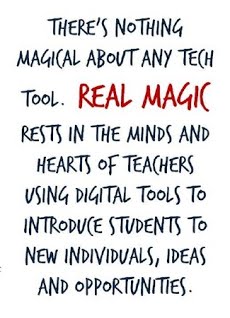 ‘The teacher’s role has changed in recent years. There has been a shift of emphasis from instructional techniques to developing learning techniques. Our role is no longer that of the “sage on the stage”. Today our role leans more towards facilitator or “guide on the side”. Our role is to increase student motivation and develop the skills or strategies that make a student more competent and to structure the learning environment so that students are able to take ownership of their own learning. Fortunately, many of the strategies that “empower” and “engage” students also lead to increased motivation.‘ – P. Thereaux, http://members.shaw.ca/priscillatheroux/motivation.html
‘The teacher’s role has changed in recent years. There has been a shift of emphasis from instructional techniques to developing learning techniques. Our role is no longer that of the “sage on the stage”. Today our role leans more towards facilitator or “guide on the side”. Our role is to increase student motivation and develop the skills or strategies that make a student more competent and to structure the learning environment so that students are able to take ownership of their own learning. Fortunately, many of the strategies that “empower” and “engage” students also lead to increased motivation.‘ – P. Thereaux, http://members.shaw.ca/priscillatheroux/motivation.html

E-Learning isn’t an end in itself, rather it is a tool that can be used. Recent research conducted by NZCER offered the following insights:
- E-learning can improve understanding and encourage deeper learning, if there is careful course design and choice of technology in relation to learning objectives that aim to encourage deeper learning.
- It can free up face-to-face teacher:student time for discussion, rather than using it to cover information or provide skill practice, depending on the use made of technology.
- It can improve and sustain motivation by offering interesting tasks and material.
- Students need formative feedback throughout the course. This requires careful structuring and the development of channels and projects encouraging student-student interaction as well as strategic use of teacher time to provide feedback; online tasks, tests, and quizzes are also useful in giving students a picture of their learning progress.
- Student-student interaction can also be enhanced through careful structuring, creating additional support for learning, and even a “learning community”. Participation in discussion groups, etc. is supported by linking it to assessment or tasks and measures that “matter”.
- It is important that students have a clear picture of the learning objectives for the course, and that assessment methods reflect and support the learning objectives.
- Students need very clear course information, and if accessing the course externally, initial face-to-face sessions are valuable to ensure understanding and skills needed to access the web material, to lay the ground for student-student interaction, particularly if some collaborative work is to be done, and for teacher-student web interaction.
- While asynchronous formats offer students more flexibility, they may also spend more time on a course using the web.
- The technology used has to be reliable, simple, and easily accessed by students.
- E-learning is easier for students who are self-managing, which may mean it is easier for mature students.
- Barriers to making the most of e-learning can arise from students’ familiarity with classroom-based methods and assumptions that this is how learning occurs, and from a greater interest in superficial learning to pass a course, than in increasing understanding.
- However, increasingly attention is focusing on the creation of tasks, material, and feedback mechanisms and channels that will increase motivation and hence encourage self-management, and on course structures, processes, and requirements that provide some additional frameworks for those who need them
(Source: New Zealand Council for Educational research, http://classes.stac.school.nz/pluginfile.php/28107/mod_resource/content/0/NZCERFinalReport.pdf )
Another very valuable tool is the Enabling E-Learning site on Te Kete Ipurangi(TKI).